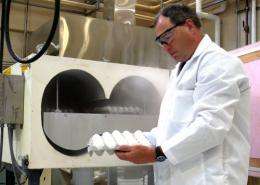Egg cooling would lessen salmonella illnesses, scientist says

While people across the country have been sickened by a recent outbreak of salmonella poisoning possibly linked to eggs from Iowa producers, a Purdue University food scientist believes the poultry industry could implement a rapid egg cooling technology to reduce future outbreaks.
Kevin Keener, an associate professor of food science, said quick cooling of eggs after they are laid would significantly reduce the ability of salmonella to grow inside eggs and potentially keep consumers from getting sick. There are no federal guidelines for how quickly eggs should be cooled, but current industry procedures can take as long as six days to cool eggs to 45 degrees F, the temperature at which salmonella can no longer grow. Keener's rapid-cooling technology would take two to five minutes.
Keener said eggs can be more than 100 F after washing and packaging in cartons. Thirty dozen eggs are then packed in a case, and 30 cases are stacked onto pallets and placed in refrigerated coolers. The eggs in the middle of the pallet can take up to 142 hours to cool to 45 degrees. He said scientists estimate that one in about every 20,000 eggs has salmonella naturally inside.
"The eggs in the middle of a pallet may take up to six days to cool, and if the one in 20,000 that has salmonella is in the middle, the bacteria will grow," Keener said. "In reality, some eggs don't cool to 45 degrees until they're in the refrigerator in your home."
Keener said Food and Drug Administration studies show that if eggs were cooled and stored at 45 degrees or less within 12 hours of laying, there would be an estimated 78 percent fewer salmonella illnesses from eggs in the United States each year.
Keener's cooling technology uses carbon dioxide "snow" to rapidly lower the eggs' temperature. Eggs are placed in a cooling chamber and carbon dioxide gas at about minus 110 degrees is generated. The cold gas is circulated around the eggs and forms a thin layer of ice inside the eggshell. After treatment, the ice layer melts and quickly lowers an egg's internal temperature to below 45 degrees. The eggshell does not crack during this process because the shell can resist expansion from a thin ice layer.
Previous studies have shown the cooling treatment would increase shelf life by four weeks.
Paul Brennan, executive vice president of the Purdue-based Indiana State Poultry Association, said so long as it did not negatively impact egg quality or producers, he would be intrigued by Keener's cooling technology.
"Our industry is good at adopting practical solutions," Brennan said. "If there is a technology that we could adopt to address an issue and it was cost-effective, I'm sure we would embrace it."
Brennan added that eggs are safe if handled and cooked properly.
"Continue to buy eggs, cook them properly and you will not have a problem from a health standpoint," Brennan said. "Food is not sterile, but industry does everything it can to eliminate the possibility of illnesses."
Keener has a prototype of his rapid-cooling technology in his Purdue laboratory and is working to optimize its function.
The FDA this month has ordered a recall of hundreds of millions of eggs thought to be contaminated by salmonella. Iowa's Hillendale Farms and Wright County Eggs are thought to be the sources of the salmonella outbreak. Salmonella poisoning can cause fever, diarrhea, nausea, vomiting and abdominal pain. More serious illnesses such as arterial infections, endocarditis and arthritis are possible but rare.



















